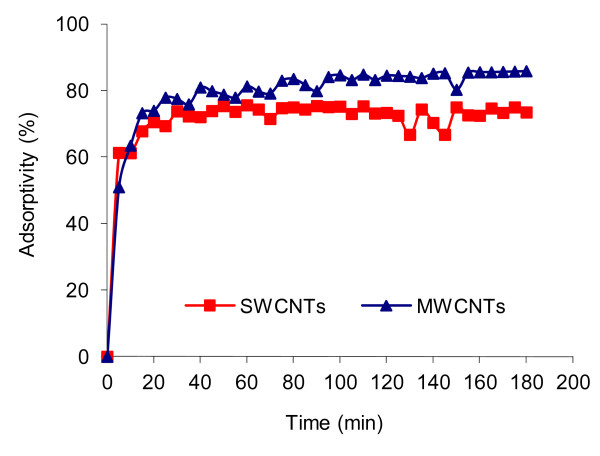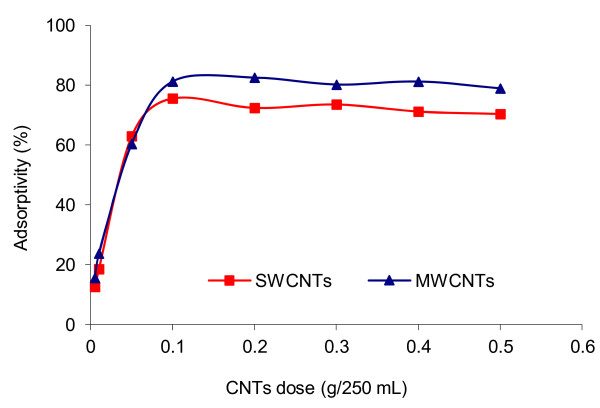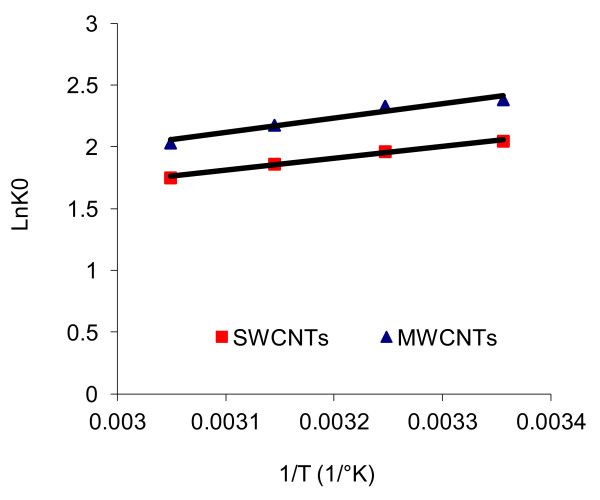Abstract
The adsorption characteristics of 4-chloro-2-nitrophenol (4C2NP) onto single-walled and multi-walled carbon nanotubes (SWCNTs and MWCNTs) from aqueous solution were investigated with respect to the changes in the contact time, pH of solution, carbon nanotubes dosage and initial 4C2NP concentration. Experimental results showed that the adsorption efficiency of 4C2NP by carbon nanotubes (both of SWCNTs and MWCNTs) increased with increasing the initial 4C2NP concentration. The maximum adsorption took place in the pH range of 2–6. The linear correlation coefficients of different isotherm models were obtained. Results revealed that the Langmuir isotherm fitted the experimental data better than the others and based on the Langmuir model equation, maximum adsorption capacity of 4C2NP onto SWCNTs and MWCNTs were 1.44 and 4.42 mg/g, respectively. The observed changes in the standard Gibbs free energy, standard enthalpy and standard entropy showed that the adsorption of 4C2NP onto SWCNTs and MWCNTs is spontaneous and exothermic in the temperature range of 298–328 K.
Keywords: Carbon nanotube, 4-Chloro-2-nitrophenol, Adsorption, Isotherm model, Thermodynamic
Introduction
Phenolic derivatives, such as a number of chloro- and nitrophenols are toxic and carcinogenic [1]. Chronic toxic effects due to phenols reported in humans include vomiting, difficulty in swallowing, anorexia, liver and kidney damage, headache, fainting and mental disturbances [2]. 4-Chloro-2-nitrophenol (4C2NP), which was chosen as the model compound in the present study, is recalcitrant and persistent towards biodegradation and is constituent intermediate of many industrial effluents [3]. While the World Health Organization (WHO) has recommended the permissible phenolic concentration of 0.001 mg/L in potable waters, the European Union (EU) has set a maximum concentration level of 0.5 μg/L of total phenols in drinking water [2,4]. Hence, removal of the phenolic compounds from wastewater before its discharge is necessary in order to reduce their side effects on the environment and human health.
Many methods such as biodegradation [5], photocatalytic degradation [6], ultrasonic degradation [7], solvent extraction [8], ozonation [9,10] and decomposition by Fenton reagents [11] may be used to remove phenolic materials from aqueous solution. However, by far, the most frequently used technology is adsorption by a solid phase.
Several different adsorbents such as activated carbon [12], silica [13], polymeric resins [14] and zeolites [15] have all been proposed to remove phenolic pollutants from wastewater. In most cases, the adsorbents have diameters in the range of submicron to micron and have large internal porosities to ensure adequate surface area for adsorption. However, the diffusion limitation within the particles leads to decreases in the adsorption rate and available capacity. Therefore, it is important and interesting to develop a novel adsorbent with a large surface area for adsorption, a small diffusion resistance and a high capacity.
The relative large specific surface area of carbon nanotubes (CNTs) enables them to become candidate for adsorption of phenolic compounds [16,17]. CNTs provide a large specific surface area and a strong Van der Waals binding energy for molecular adsorbates on well-defined adsorption sites such as interior, groove, exterior and interstitial sites [18].
The objective of the present work was to investigate the adsorption potential of single-walled and multi-walled carbon nanotubes (SWCNTs and MWCNTs) for removal of 4C2NP from aqueous solutions. Effects of contact time, CNTs dosage, pH and initial 4C2NP concentration on the adsorption capacity were studied. The Langmuir, Freundlich and Temkin isotherm models were used to describe the equilibrium data. The adsorption mechanisms of 4C2NP from aqueous solutions onto SWCNTs and MWCNTs were also evaluated in terms of thermodynamic parameters.
Materials and methods
Materials
Single-walled and multi-walled carbon nanotubes were purchased from Research Institute of Petroleum Industry (R.I.P.I), of Iran. On the basis of the information provided by the manufacturer, the CNTs were synthesized by catalytic chemical vapor deposition (CVD), and their characteristics are listed in Table 1. 4-Chloro-2-nitrophenol (C6H4ClNO3, Mw = 173.56 g/mol) was supplied by Fluka, Germany.
Table 1.
Characteristics of SWCNTs and MWCNTs
| Adsorbent | Outer diameter (nm) | Length (μm) | Specific surface area (m2/g) | Purity (%) |
|---|---|---|---|---|
| SWCNTs |
1-2 |
5-15 |
550 |
>95% |
| MWCNTs | <10 | 5-15 | 280 | >95% |
Adsorption experiments
Adsorption of 4C2NP onto CNTs was carried out by a batch method to obtain equilibrium data. The variation of 4C2NP concentration versus time in the aqueous solution was monitored under various conditions such as CNTs doses (0.005-0.5 g/250 mL), initial pH (2–12) and initial 4C2NP concentrations (2–10 mg/L). Stock solution was prepared by dissolving the required amount of 4C2NP in double distilled water (pH = 6). The initial pH was adjusted by adding either HCl or NaOH. Adsorption was achieved by adding a known amount of CNTs into 250 mL of 4C2NP solution of known concentration, pH and temperature in a 500 mL Erlenmeyer flask. The mixture was shaken in a shaking water bath at a speed of 140 shakes/min; samples were taken at predetermined time intervals and then centrifuged (Hettich/UNIVERSAL 16-R) at 10000 rpm for 10 min. Analysis of remained 4C2NP in the solution was done using a UV-160 Shimadzu UV–vis spectrophotometer at a wavelength of 219 nm (acidic pHs) or 234 nm (neutral and alkaline pHs). The adsorption yield (%) and amounts of adsorbed 4C2NP at equilibrium, i.e. qe (mg/g), were calculated from the following equations (1–2), respectively:
| (1) |
| (2) |
where C0, Ct and Ce are the initial, at any time t and equilibrium 4C2NP concentration (mg/L), respectively. V is the solution volume (L) and m is the adsorbent mass (g).
Adsorption isotherm and thermodynamic studies
One of the most important studies to optimize the design of an adsorption process is to establish the adsorption isotherm. Adsorption isotherm studies were carried out with different initial 4C2NP concentrations ranging from 2 to 10 mg/L, with 0.1 g of CNTs at 25°C and pH = 6. Equilibrium adsorption isotherm data were analyzed according to the linear forms of Langmuir [19], Freundlich [20] and Temkin and Pyzhev [21] adsorption isotherm equations (35), respectively:
| (3) |
| (4) |
| (5) |
Where, qm is the maximum adsorption at monolayer (mg/g) and KL is the Langmuir constant including the affinity of binding sites (L/mg). KF and n are the Freundlich constants indicating adsorption capacity [(mg/g)(L/mg)1/n] and intensity, respectively. KT and B1 are the Temkin constants (KT is the equilibrium binding constant (L/g) and B1 is related to the heat of adsorption). The Langmuir isotherm can also be represented in terms of a dimensionless constant separation factor or an equilibrium parameter, RL, which is defined as:
| (6) |
The RL value indicates the type of the isotherm to be either irreversible (RL =0), favorable (0<RL <1), linear (RL =1) or unfavorable (RL >1) [22].
Thermodynamic studies were performed to find the nature of adsorption process. These studies were carried out in the temperature range of 298–328 K, at an initial 4C2NP concentration of 10 mg/L, with 0.1 g of CNTs at pH = 6. Thermodynamic parameters, namely standard enthalpy (ΔH°), standard entropy (ΔS°) and Gibbs standard free energy (ΔG°) were calculated by using equations (79), [23]:
| (7) |
| (8) |
| (9) |
where K0 is the equilibrium constant, T is the solution temperature (K) and R is the gas constant (8.314 J/mol.K) .
Results
Effect of contact time
In order to optimize contact time of adsorption, 0.1 g of adsorbent (SWCNTs or MWCNTs) was treated by 250 mL of 4C2NP solution with 10 mg/L concentration at 25°C. The working pH was that of stock solution (i.e., pH ≈ 6) and was not controlled. The mixture was shaken during different times and left for 180 min and then, was analysed (Figure 1). Rapid adsorption was observed during the first 20 min of contact time and no significant change in 4C2NP removal was observed after about 60 min. Therefore, 60 min was selected as the equilibrium time for both adsorbents in all experiments.
Figure 1.
Effect of contact time on 4C2NP adsorption onto CNTs; [4C2NP]0 = 10 mg/L; pH = 6; CNTs dose = 0.1 g; 25°C.
Effect of CNTs dose
To study the effect of SWCNTs and MWCNTs dose on the adsorption of 4C2NP, the experiments were done under the conditions described at previous stage with contact time of 60 min and variable CNTs dosage (0.005, 0.01, 0.05, 0.1, 0.2, 0.3, 0.4 and 0.5 g/250 mL). Figure 2 displays the effect of CNTs dose on the adsorption of 4C2NP. Along with the increase of adsorbent dosage (from 0.005-0.1 g), the percentage of 4C2NP adsorbed increased (from 12.64%-75.62% and 15.6%-81.28%) onto SWCNTs and MWCNTs, respectively. The adsorption of 4C2NP at adsorbent dosage higher than 0.1 g remained almost unchanged. As a result, the CNTs dose of 0.1 g was used in the subsequent experiments of this work.
Figure 2.
Effect of CNTs dose on 4C2NP adsorption; [4C2NP]0 = 10 mg/L; pH = 6; 25°C; contact time = 60 min.
Effect of initial pH
In Figure 3, the effect of initial pH on the adsorption of 4C2NP onto SWCNTs and MWCNTs at 25°C and initial 4C2NP concentration of 10 mg/L is depicted. As shown, adsorption of 4C2NP remained almost unchanged up to pH = 6, but dropped drastically for pH >6. Thus in the rest of the experiments, to achieve the appropriate condition of adsorption, the pH was that of stock solution (pH ≈ 6) and was not controlled.
Figure 3.
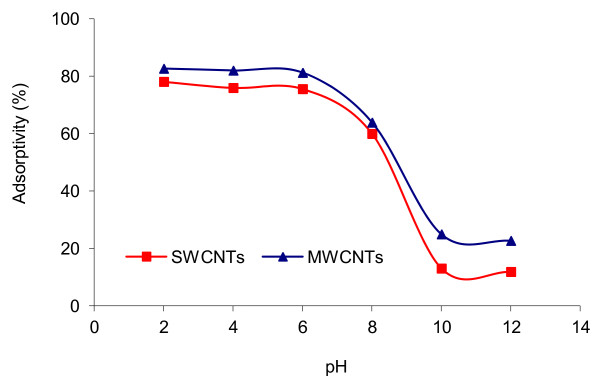
Effect of pH on 4C2NP adsorption onto CNTs; [4C2NP]0 = 10 mg/L; CNTs dose = 0.1 g; 25°C; contact time = 60 min.
Effect of initial concentration
The adsorption of 4C2NP was carried out at different initial concentrations ranging from 2 to 10 mg/L onto SWCNTs and MWCNTs at 25°C. As shown in Figure 4, when the initial concentration increased from 2 to 10 mg/L, the adsorption increased from 33.19% to 75.62% and from 56.96 to 81.28% onto SWCNTs and MWCNTs, respectively.
Figure 4.
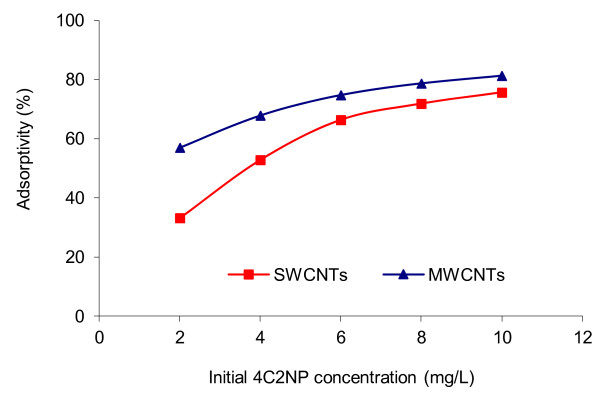
Effect of 4C2NP initial conc. on its adsorption onto CNTs; pH = 6; CNTs dose = 0.1 g; 25°C; contact time = 60 min.
In order to compare the results of adsorption of 4C2NP onto SWCNTs and MWCNTs at various conditions such as pH, CNTs dosage and initial 4C2NP concentration, the difference of 4C2NP adsorption by SWCNTs and MWCNTs has been evaluated by t-test and are recorded in Table 2. As tcritical>tsample, there was no significant difference between the adsorption of 4C2NP onto SWCNTs and MWCNTs (p = 0.05).
Table 2.
Results of t-test
| Parameter | t-test |
|---|---|
| pH |
0.410 |
| CNTs dosage | 0.432 |
| Initial 4C2NP concentration | 1.344 |
Adsorption isotherm studies
The values of Langmuir, Freundlich and Temkin parameters were calculated from the slope and intercept of linear plots of 1/qe vs. 1/Ce, Lnqe vs. LnCe and qe vs. LnCe (equations 3–5) respectively. The isotherm constants along with the correlation coefficients are listed in Table 3. It can be seen from Table 3, that the Langmuir isotherm better fited the experimental data (R2 >0.99) than the other isotherms.
Table 3.
Isotherm parameters for 4C2NP adsorption onto CNTs
|
Adsorbent |
C0 |
Langmuir |
Freundlich |
Temkin |
|||||||
|---|---|---|---|---|---|---|---|---|---|---|---|
| qm | KL | RL | R2 | n | KF | R2 | B1 | KT | R2 | ||
| SWCNTs |
2 |
1.444 |
0.406 |
0.55 |
0.993 |
0.242 |
2.088 |
0.901 |
27.434 |
0.3 |
0.854 |
| |
4 |
|
|
0.38 |
|
|
|
|
|
|
|
| |
6 |
|
|
0.29 |
|
|
|
|
|
|
|
| |
8 |
|
|
0.23 |
|
|
|
|
|
|
|
| |
10 |
|
|
0.19 |
|
|
|
|
|
|
|
| MWCNTs |
2 |
4.426 |
0.459 |
0.52 |
0.994 |
0.393 |
3.962 |
0.893 |
21.371 |
1.217 |
0.884 |
| |
4 |
|
|
0.35 |
|
|
|
|
|
|
|
| |
6 |
|
|
0.26 |
|
|
|
|
|
|
|
| |
8 |
|
|
0.21 |
|
|
|
|
|
|
|
| 10 | 0.17 | ||||||||||
Adsorption thermodynamic studies
ΔH° and ΔS° were calculated from the slope and intercept of the plot of LnK0 vs. 1/T using the equation 7 (Figure 5). Standard Gibbs free energies at different temperatures were calculated from equation 9 and the results are summarized in Table 4.
Figure 5.
Plot of LnK0vs. 1/T; [4C2NP]0 = 10 mg/L; pH = 6; CNTs dose = 0.1 g; contact time = 60 min.
Table 4.
Thermodynamic parameters for 4C2NP adsorption onto CNTs
| ΔG° (kJ/mol) | ΔH° (kJ/mol) | ΔS° (J/mol.K) | R2 | ||||
|---|---|---|---|---|---|---|---|
| |
298 K |
308 K |
318 K |
328 K |
|
|
|
| SWCNTs |
−5.100 |
−5.001 |
−4.902 |
−4.804 |
−8.043 |
−9.875 |
0.991 |
| MWCNTs | −5.985 | −5.858 | −5.731 | −5.604 | −9.769 | −12.697 | 0.954 |
Discussion
As shown in Figure 1, a two-stage kinetic behavior was observed: rapid initial adsorption in a contact time of 20 min, followed by a second stage with a much lower adsorption rate. This is obvious from the fact that a large number of vacant surface sites are available for the adsorption during the initial stage and with the passage of time, the remaining vacant surface sites are difficult to be occupied due to repulsive forces between the solute molecules on the solid phase and in the bulk liquid phase [24]. Also Figure 1, shows that MWCNTs had slightly higher adsorbability than SWCNTs, despite the fact that SWCNTs have a higher specific surface area (550 m2/g) than MWCNTs (280 m2/g). This observation is similar with other researches [17], which may be explained by the presence more active adsorbing sites for MWCNTs compared SWCNTs. While MWCNTs have three possible sites for adsorption including external surface, inner cavity (the spaces in the innermost graphite tube) and interwall spaces (the spaces between the coaxial tubes of MWCNTs), SWCNTs have only two possible sites including external surface and inner cavity [18].
Based on the results (Figure 2), an increase in the adsorption with the increase of adsorbent dosage from 0.005-0.1 g can be attributed to greater surface area and the availability of more adsorption sites. Above 0.1 g of adsorbent dosage, the adsorption equilibrium of 4C2NP was reached and the removal of 4C2NP remained almost constant.
The solution pH is one of the key factors that controls the adsorption process on carbon materials; it controls the electrostatic interactions between the adsorbent and the adsorbate [24]. The pH of the zero point of charge (pHzpc) for SWCNTs and MWCNTs are 2.2 and 4.7-6.4, respectively [25]. At pH <6, since there is no electrostatic repulsion between the non-ionized 4C2NP species and the CNTs surfaces, the adsorption is higher. On the other hand for pH >pKa (4-chloro-2-nitrophenol, pKa = 6.46, 25°C), the phenols dissociate, forming phenolate anions, while the surface of CNTs is negatively charged. The electrostatic repulsion between the identical charges lowers the adsorption capacities. Besides, the phenolate anions are more soluble in the aqueous solution, and stronger adsorbate-water bonds must be broken before adsorption can take place [26]. Similar results were reported for the adsorption of phenol and cresol on carbon nanoporous [24] and 2-nitrophenol by MWCNTs [16].
It is clear from Figure 4, that the adsorption of 4C2NP onto CNTs was increased by increasing the initial 4C2NP concentration. These results may be explained by the fact that, the initial concentration provides the necessary driving force to overcome the resistances to the mass transfer of 4C2NP between the aqueous and the solid phases. Furthermore, the increase of loading capacity of CNTs with increasing initial 4C2NP concentration may be due to higher interaction between 4C2NP and CNTs [27].
Table 3 revealed that the adsorption of 4C2NP onto CNTs can be described with Langmuir isotherm. It can be seen from this Table that the calculated RL values were between 0 and 1 for both the adsorbents, indicating favorable conditions for the adsorption process. KL values for adsorbents followed the order of MWCNTs >SWCNTs, suggesting that the affinity of the binding sites for 4C2NP on CNTs also followed this order.
According to the results (Table 4), the negative values of ΔG° show a spontaneous nature of adsorption. The decrease in ΔG° with the decrease of temperature reveals more efficient adsorption at lower temperatures. In addition, a comparison of the standard Gibbs free energy values indicates that the adsorption onto MWCNTs is more spontaneous than SWCNTs. Hence, the amounts of ΔG° imply that the adsorption affinity of 4C2NP onto MWCNTs is stronger than SWCNTs. The negative value of ΔH° suggests that the 4C2NP-CNTs interaction is exothermic, which is the reason for the increase in adsorption at lower temperatures. Also, it suggests that the rise in the solution temperature dose not favor 4C2NP adsorption on either SWCNTs or MWCNTs. The same effect was reported for pentachlorophenol on MWCNTs [17]. The standard entropy change was found to have negative values for those processes. It mirrors a decrease in the randomness at solid-solution interface during the adsorption of 4C2NP onto SWCNTs and MWCNTs surfaces.
Competing interests
The authors declare that they have no competing interests.
Authors’ contributions
AM and PG carried out the isotherms studies and participated in the drafted the manuscript. MA and SD carried out the effect of different parameters studies. MM and KZ carried out the thermodynamic Studies. All authors read and approved the final manuscript.
Contributor Information
Ali Mehrizad, Email: ali.mehrizad@yahoo.com.
Mehran Aghaie, Email: m-aghaie@iau-tnb.ac.ir.
Parvin Gharbani, Email: p-gharbani@iau-ahar.ac.ir.
Siavoush Dastmalchi, Email: dastmalchi.s@tbzmed.ac.ir.
Majid Monajjemi, Email: m_monajjemi@yahoo.com.
Karim Zare, Email: info@dr-karimzare.com.
Acknowledgements
The authors thank the financial support from the School of Pharmacy, Tabriz, Iran, specially Dr. Hamidi and Miss Faridi.
References
- Chen S, Xu ZP, Zhang O, Lu GQ, Hao ZP, Liu S. Studies on adsorption of phenol and 4-nitrophenol on MgAl-mixed oxide derived from MgAl-layered double hydroxide. Sep Purif Technol. 2009;67(2):194–200. doi: 10.1016/j.seppur.2009.03.016. [DOI] [Google Scholar]
- Dursun AY, Tepe O. Internal mass transfer effect on biodegradation of phenol by Ca-alginate immobilized Ralstonia eutropha. J Hazard Mater. 2005;126(1–3):105–111. doi: 10.1016/j.jhazmat.2005.06.013. [DOI] [PubMed] [Google Scholar]
- Saritha P, Aparana C, Himabindu V, Anjaneyulu Y. Advanced oxidation of 4-chloro-2-nitrophenol (4C-2-NP)–a comparative study. J Hazard Mater. 2007;149(3):609–614. doi: 10.1016/j.jhazmat.2007.06.111. [DOI] [PubMed] [Google Scholar]
- Guidelines for Drinking water Quality: Incorporating First and Second Addenda. 3rd Ed. Vol. 1. World Health Organization, Geneva; 2008. [PubMed] [Google Scholar]
- Movahedyan H, Khorsandi H, Salehi R, Nikaeen M. Detection of phenol degrading bacteria and pseudomonas putida in activated sludge by polymerase chain reaction. Iran J Environ Healh Sci Eng. 2009;6(2):115–120. [Google Scholar]
- Hemmati Borji S, Nasseri S, Nabizadeh Nodehi R, Mahvi AH, Javadi AH. Photocatalytic degradation of phenol in aqueous solutions by Fe(III)-doped TiO2/UV process. Iran J Health & Environ. 2011;3(4):369–380. [Google Scholar]
- Maleki A, Mahvi AH, Vaezi F, Nabizadeh R. Ultrasonic degradation of phenol and determination of the oxidation by-products toxicity. Iran J Environ Healh Sci Eng. 2005;2(3):201–206. [Google Scholar]
- Palma MSA, Paiva JL, Zilic M, Converti A. Batch phenol removal from methyl isobutyl ketone by liquid-liquid extraction with chemical reaction. Chem Eng Process. 2007;46(8):764–768. doi: 10.1016/j.cep.2006.10.003. [DOI] [Google Scholar]
- Benitez FJ, Beltran-Heredia J, Acero JL, Rubio FJ. Rate constants for the reactions of ozone with chlorophenols in aqueous solutions. J Hazard Mater B. 2000;79(3):271–285. doi: 10.1016/S0304-3894(00)00269-7. [DOI] [PubMed] [Google Scholar]
- Gharbani P, Khosravi M, Tabatabaii SM, Zare K, Dastmalchi S, Mehrizad A. Degradation of trace aqueous 4-chloro-2-nitrophenol occurring in pharmaceutical industrial wastewater by ozone. Int J Environ Sci Tech. 2010;7(2):377–384. [Google Scholar]
- Farrokhi M, Mesdaghinia AR, Yazdanbakhsh AR, Nasseri S. Characteristics of Fenton’s oxidation of 2, 4, 6 trichlorophenol. Iran J Environ Healh Sci Eng. 2004;1(1):12–18. [Google Scholar]
- Tseng RL, Wu KT, Wu FC, Juang RS. Kinetic studies on the adsorption of phenol, 4-chlorophenol, and 2,4-dichlorophenol from water using activated carbons. J Environ Manage. 2010;91(11):2208–2214. doi: 10.1016/j.jenvman.2010.05.018. [DOI] [PubMed] [Google Scholar]
- Roostaei N, Tezel FH. Removal of phenol from aqueous solutions by adsorption. J Environ Manage. 2004;70(2):157–164. doi: 10.1016/j.jenvman.2003.11.004. [DOI] [PubMed] [Google Scholar]
- Abburi K. Adsorption of phenol and p-chlorophenol from their single and bisolute aqueous solutions on Amberlite XAD-16 resin. J Hazard Mater. 2003;105(1–3):143–156. doi: 10.1016/j.jhazmat.2003.08.004. [DOI] [PubMed] [Google Scholar]
- Koh S, Dixon JB. Preparation and application of organominerals as adsorbents of phenol, benzene and toluene. Appl Clay Sci. 2001;18(3–4):111–122. [Google Scholar]
- Arasteh R, Masoumi M, Rashidi AM, Moradi L, Samimi V, Mostafavi ST. Adsorption of 2-nitrophenol by multi-wall carbon nanotubes from aqueous solutions. Appl Surf Sci. 2010;256(14):4447–4455. doi: 10.1016/j.apsusc.2010.01.057. [DOI] [Google Scholar]
- Abdel Salam M, Burk R. Thermodynamics and kinetics studies of pentachlorophenol adsorption from aqueous solutions by multi-walled carbon nanotubes. Water Air Soil poll. 2010;210(1–4):101–111. [Google Scholar]
- Ren X, Chen C, Nagatsu M, Wang X. Carbon nanotubes as adsorbents in environmental pollution management: a review. Chem Eng J. 2011;170(2–3):395–410. [Google Scholar]
- Langmuir I. The constitution and fundamental properties of solids and liquids. J Am Chem Soc. 1916;38(11):2221–2295. doi: 10.1021/ja02268a002. [DOI] [Google Scholar]
- Freundlich HMF. Uber die adsorption in losungen. Z Phys Chem. 1906;57(A):385–470. [Google Scholar]
- Temkin M, Pyzhev V. Kinetics of the synthesis of ammonia on promoted iron catalysts. Jour Phys Chem (U.S.S.R.) 1940;13:851–867. [Google Scholar]
- McKay G, Blair HS, Gardiner JR. Adsorption of dyes on chitin. J Appl Polym Sci. 1982;27(8):3043–3057. doi: 10.1002/app.1982.070270827. [DOI] [Google Scholar]
- Moradi O, Zare K, Monajjemi M, Yari M, Aghaie H. The studies of equilibrium and thermodynamic adsorption of Pb(II), Cd(II) and Cu(II) Ions from aqueous solution onto SWCNTs and SWCNT–COOH Surfaces. Fuller Nanotub Car N. 2010;18(3):285–302. doi: 10.1080/15363831003783005. [DOI] [Google Scholar]
- Anbia M, Ghaffari A. Adsorption of phenolic compounds from aqueous solutions using carbon nanoporous adsorbent coated with polymer. Appl Surf Sci. 2009;255(23):9487–9492. doi: 10.1016/j.apsusc.2009.07.070. [DOI] [Google Scholar]
- Klaine SJ, Alvarez PJJ, Batley GE, Fernandes TF, Handy RD, Lyon DY, Mahendra S, McLaughlin MJ, Lead JR. Nanomaterials in the environment: Behavior, fate, bioavailability, and effects. Environ Toxicol Chem. 2008;27(9):1825–1851. doi: 10.1897/08-090.1. [DOI] [PubMed] [Google Scholar]
- Terzyk AP. Further insights into the role of carbon surface functionalities in the mechanism of phenol adsorption. J Colloid Interf Sci. 2003;268(2):301–329. doi: 10.1016/S0021-9797(03)00690-8. [DOI] [PubMed] [Google Scholar]
- Shahryari Z, Soltani GA, Azadi M. Experimental study of methylene blue adsorption from aqueous solutions onto carbon nano tubes. Int J Water Res Environ Eng. 2010;2(2):16–28. [Google Scholar]



